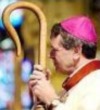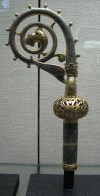Patriarchal Cross


The Patriarchal Cross (heraldic: Patriarcale), with or without a Corpus, is a cross (such as a Latin Cross or Budded Cross) with an additional cross-beam.
Other names include:
• Archiepiscopal Cross or Crux Gestatoria
• Archbishop's Cross
• Metropolitan Cross
• Double Cross
Of those latter two names Metropolitan is related to the civic area.
In some cities today, the term Metro is most familiar in the context of a city's underground railways. The context for this page is ecclesiastical rather than civil.
Meter is the Greek for 'mother' and polis is the Greek for 'city' (from which we get the words 'policy' and 'police'). Metropolis originally meant 'mother city' and a Metropolitan was somebody from that city. The term was reserved for higher ranking citizens and eventually 'The Metropolitan' was used only in reference to the chief of that metropolis. Since church leaders were also civil leaders, the highest ranking in the local church was The Metropolitan.
In the Greek and Eastern Orthodox Churches the Metropolitan is the head of an ecclesiastical province, ranking just below the Patriarch. In the Church of England and Roman Catholic Church the Metropolitan is an Archbishop.
Referring to this as a Double Cross might confuse with the meaning 'cheat' or 'betray'. The term Double-Beamed Cross avoids this confusion.
The origin of (the betraying) 'double-cross' is unclear. William Stevenson's book, 'A Man Called Intrepid', about the World War II spymaster of the British secret service, claims that operations were planned in room 20 of the headquarters building. The number-plate on the door displayed the Roman numerals 'XX', which gave one particular mission the code word 'Double-cross'.
It's a plausible story but the term was in use long before the Second World War (for example W Harrison Ainsworth's 1834 poem 'Double-cross', re-published in Musa Pedestris, Three Centuries of Canting Songs and Slang Rhymes).
This cross is often confused with the Cross of Lorraine, which originates from the Patriarchal Cross.
There are several explanations for this 'extra' beam:
- The most popular idea is that the upper beam, also seen on the Russian and Eastern Orthodox cross, represents the plaque bearing the name of the crucified victim. For example, Pontius Pilate's inscription "Jesus the Nazorean, King of the Jews" (see INRI). Such a plaque is known in Latin as titulus cruces and therefore this form is sometimes called the Titulus Cross.
- Another explanation is that the first beam represents the death of Jesus Christ and the second beam his resurrection.
- A third view is that the first beam symbolises secular power and the second beam the ecclesiastic power of Byzantine emperors. In the 9th century, this was a political symbol used by Byzantine clerks and missionaries.
Occasionally, the shorter crossbeam is diagonal, near the bottom, similar to the lower beam of the Orthodox Cross.
- Where the lower beam is diagonal, it commonly represents a foot-support (see suppedaneum) angled like a balance scale showing the good thief, St. Dismas, having accepted Christ would ascend to heaven and be on God's right hand, while the thief who mocked Jesus would descend to hell.
Origin
It is conjectured that the double-beamed cross form was first used in ancient Samaria (now the Hashemite Kingdom of Jordan) as an ideogram for rulership, since it depicted a shepherd's crook.
For a long time the bishops of Rome claimed the exclusive right to carry the cross. In the 12th century it was granted to metropolitans and patriarchs, and to archbishops in the time of Gregory IX (1227–1241). The patriarchs of the Greek Church tended to carry lamps and burning candles rather than the cross.
The original of the word patriarch is not difficult to guess: patri: father, male elder; and arch: over something, like the arch of a bridge. Another (less common) term is hierarch, which is also the title of an ecclesiastical elder, and a word that gives us hierarchy. Be aware, however, that the adjective for hierarchy is hierarchical, not hierarchal, which is the adjective of hierarch.
That's enough about the word. What about the symbol?
Use

With this ruler/shepherd image in mind, it was adopted for use as a Patriarchal Cross and included in the heraldic arms of an archbishop. It is also frequently used as a crozier.
In Catholic and Orthodox Christianity, 'Patriarch' is the title of a bishop who has the highest juridical rank.
This cross was the arms of the Patriarch of Jerusalem, who granted its use to the Knights Templar. The Duke of Lorraine, Godefroy de Boullion, used it for his standard when he took part in the capture of Jerusalem. The cross was then passed on to his successors as heraldic arms and became known as the Cross of Lorraine.
In ecclesiastical processions an archbishop is preceded by a cross-bearer. Such Processional Patriarchal Crosses are silver or gilded and bear a Corpus. The cross is carried with the figure turned towards the archbishop.
In Freemasonry, the Patriarchal Cross is often leaning. (See Portate Cross.)
'Patriarch' comes from the Greek word to describe the man who had autocratic authority over an extended family. Its meaning now varies according to the religion in which it is used. The Mormons for example, use the term for the person empowered to bestow blessings on other Mormons.
Patriarchs exist in Eastern Orthodoxy and Oriental Orthodoxy but in the Roman Catholic Church, the title was renounced in 2006.
In Freemasonry a single barred cross is known as a Passion Cross and with three bars is known as a Salem Cross, signifying the ultimate rank of the wearer. See also Cross and Crown.






